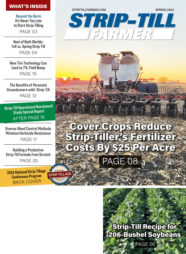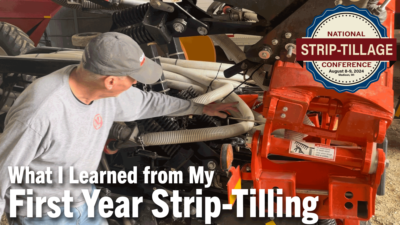Bill Preller says hard economics as well as other factors are quickly moving strip-till from fad to mainstream with U.S. farmers.
“When it’s done right, it makes money, and today’s strip-till equipment has come of age to the point that it will deliver on the agronomic challenges farmers face,” he says. “The cold, hard economics show a grower can buy a piece of equipment and pay for it within 2 years or less. People notice that. In addition, strip-till addresses increasing environmental concerns about erosion and plant nutrient placement.”
Preller is president and founder of AGuru Machinery, a 2018 startup specializing in strip-till hardware and information on how to use it. His career spans agronomy research and crop consulting in the 1980s and a long tenure with major OEMs as a leader in ag equipment sales and marketing.
“Our goal is to use our experience over a lifetime of interaction with farmers and in the equipment business to eliminate the compromises in strip-till management,” he says.
Preller says growers universally deal with crop residue management, soil tilth, plant nutrient availability and seedbed conditions. Achieving the right balance of each involves many compromises tied to equipment, crops, weather and soil types.
“Any soil management system deals with those four categories, and we think strip-till offers excellent opportunities to get it right,” he explains.
Why Strip-Till Works
Preller explains today’s dominant farming method, mulch-tilling, deliberately mixes residue into the soil where seed will be planted. That doesn’t matter much when planting soybeans or dry beans, but he says it’s a profit-robbing compromise for wheat and corn. The residue in the seedbed invariably interferes with good seed-to-soil contact — reducing stand uniformity and ultimately overall yields.
“Our data shows strip-till done right will consistently provide a stand advantage in corn of 1,500-2,000 plants over the best mulch-till because it helps eliminate residue in the seed zone, which delays emergence,” Preller says. “Then, when it invariably turns hot and dry in August, strip-till provides another yield bump because strips built pre-planting have improved soil tilth (root access to nutrients, oxygen and moisture) to allow abundant root development, which can provide the crop with moisture during summer’s heat stress.”
Preller says strip-till’s late-season advantage even extends to many no-till fields, particularly those in which natural or compaction-caused soil pan formations prevent deep root development.
“We’re seeing fields that have been in no-till for years showing significant corn yield increases when planted behind a strip-till machine,” he says. “Most of the increase comes from roots developing further into the soil profile, enabling better access to nutrients and water.”
Regardless of what tillage practices you’ve used, Preller says the key is to remember that you’re preparing a seedbed.
“You do not want to mix residue into the area to be planted because it inhibits good seed-to-soil contact,” Preller says. “Strip-till virtually eliminates this problem, as long as the residue is moved out of the strip ahead of the row unit. Good strip-till practices excel in many soil conditions because of the seedbed it produces for uniform, successful stand emergence.”
Preller says because of the improved harvests behind strip-till “done right,” a farm family with a 12-row strip-till rig can pay for that implement on 2,000-4,000 acres in about a year and a half.
“If you go top end with the most expensive equipment and run it hard, it will pay for itself in about a year on 4,000-6,000 acres,” he says.
Available Tools
Strip-till equipment breaks down into three categories of ground-engaging equipment: knives, coulters and shanks.
Preller says knives are most prevalent in areas where strip-till evolved from converted anhydrous ammonia applicators and are more typical in central and northern Corn Belt fields. According to Strip-Till Farmer’s most recent Strip-Till Operational Practices Benchmark Study, 22% of responding farmers use mole knives.
Nearly double that number — 40% — of farmers use the coulter system, a more recent adaptation. Preller says it’s more prevalent in areas with rocky fields, where knives and shanks pull rocks to the surface.
“No-tillers converting to strip-till and wanting less soil disturbance, growers who are looking for just a seedbed and not deep-placement of fertilizer or deep soil fracture, generally look at coulter-equipped machines,” he says. “Also growers looking for higher field speeds tend to prefer coulters because they can cover more acres quickly by not running deeply to improve soil tilth or place fertilizer.”
Shanks, the tool Preller calls the original dedicated strip-till approach, were most popular with benchmark survey respondents. Fifty-eight percent say they use shanks when strip-tilling.

“Power is directly related to the amount of soil moved, and the efficiency of the equipment design running at that depth…” – Bill Preller
“The shank’s predominant origin and use is in the western Corn Belt where more soil disturbance is sought,” Preller explains. “It is more typically adopted by strip-tillers converting out of mulch-till. They know a shank is their disc ripper and use it in strip-till.”
Also, the shank is typically the tool of preference when deeper nutrient banding is desired.
Cost Comparison
The cost of the three systems is less about the choice of ground-engaging tools and more about the overall strength and weight of the strip-till machine.
“Also, it’s about the overall level of technology on board,” Preller explains. “For example, there are low-cost coulter and knife units — generally entry level — for smaller acreage use in lighter, easier-operating conditions. Then there are more expensive coulter units built heavier and stronger and equipped with more technology.
“Knife units in general are lower cost, but some of that is due to the fact many knife units are legacy fertilizer toolbars upgraded for strip-till. Many times, they will feature rigid frame mounted shanks instead of more ground following parallel-link arms.
“Shank machines in general are the highest-cost row units, because they are typically built the heaviest and strongest to take the draft load of running the shank deep in the soil,” he says. “Overall, however, there is as much range across all three designs, especially across coulters and shanks, as there is between them.”
To illustrate the point that there is as much range in price/cost within a strip till unit type, here are some rough market ranges. Knife machines can be below $2,000 per row for a simple rigid shank applicator style unit, and can go to $5,000 per row for a higher end unit with more on-board technology. Coulter units likely have the broadest range. Simple light units may start at $2,000 a row for a strip freshener or very light duty strip till unit, and can go to $7,000 a row for higher-end heavier units. Shank units likewise have a wide range, with prices per row from $4,500 to $7,500.
Nutrient Placement
A knife forms a band of nutrients toward the depth it runs. Some units feature adjustable depth placement that releases fertilizer above the bottom of the point, but even then, adjustments are limited.
“Single coulter units tend to produce a vertical band because the fertilizer is placed directly in the path of the coulter,” Preller says. “Dual or multiple coulter units tend to mix the fertilizer in a zone where the coulters run. Depending upon the depth and width of the coulter-tilled area, the nutrients can be placed in a narrow, shallow zone, or they may inhabit the entire depth and width of the coulters – producing a much larger zone of fertility instead of a band.
Shank units are similar to knife units in that the fertility goes in a band behind the shank or point. Some units may have adjustable depth fertilizer release points, but at least some of the nutrients typically end up at the bottom of the shank/point running depth, with a small — 1-3-inch — vertical band above that, if a deflector is used.
“Zone and band placement each have advantages in certain soil conditions,” Preller says. “A tighter band may do better in heavy clay soils, which tend to bind up nutrients, or in extremely low fertility soils. Deeper placement will do better in drier seasons, especially during ear-fill. Both have advantages of sub-surface placement in the general area of root development.”
Power Requirements
Preller says “coffee shop wisdom” equates coulter machines with lower power requirements, but he adds that is not necessarily true.
“Power is directly related to the amount of soil moved, and the efficiency of the equipment design running at that depth,” he explains. “In general, coulters take less power because they are running at more shallow depths, but they likely will require additional power when running more deeply.
“An example is a multiple-coulter unit running 5-6 inches deep may require equal/more power compared with a knife running the same depth. The knife is breaking out a “V” of soil, whereas the coulters are moving the entire width of the coulter tillage area to the depth at which they are run,” he adds.
Power is also directly related to field speed.
“Coulter units can run faster than knives or shanks,” Preller says. “So they may take more power even when run shallower, but that is attributed to the increased speed. The advantage would be they cover more acres per hour, but with more power.”
Preller suggests thinking of the power equation as “the amount of soil moved in a given amount of time.”
“Moving more soil takes more power. Running faster (more soil moved per time) takes more power. It’s all common sense, so beware of thinking the coulter always requires less power,” he explains.
As a starting point, coulter units run shallow may only take 5 hp per row, in light soils and not run fast. As speed and depth increases, coulter units may take up to 30 hp per row, when run at 6 inches deep at 10 mph. Knives are more consistent, and vary mostly on soil type, taking from 10-25 hp per row. Shank hp per row is heavily dependent on soil type and depth run — a typical situation goes from 20-25 hp, although when run deeper in hard soils it may take up to 40 hp per row.
Decision Making
Once you know how much you can spend and how much you can pull, Preller suggests following this three-part decision guide based on individual farm soils and management needs:
- Want to address soil tilth and water and air circulation deeper within the root zone? Choose shanks.
- Want to make a more uniform seed bed, with less depth or soil disturbance? Choose coulters.
- Want to band fertilizer deeper in the root zone? Choose a knife or shank. Go with the shank if you want to go deeper.
What Your Neighbors are Running
As we planned this article on the basics of strip-till ground-engaging equipment, we thought it would be helpful to see what our readers are using and why. Here are some of the responses we received to our October 2021 survey.
I use coulters because knives and shanks smear my soil too much. I farm mostly heavy clay river bottom ground.
– Chris Newman, Sloan, Iowa
We’re transitioning to strip-till from no-till and mulch-till. We have a machine capable of running shanks or coulters, which is the main reason we chose the brand we did. This will be our first fall using shanks. We used coulters this spring on half our ground. Early harvest results on beans are showing a 5-6 bushel-per-acre advantage of strips over mulch-till.
– Mike Schardt, Carleton, Neb.
Because our ground is rolling, we’ve found it necessary to only do spring strip-till ahead of a twin-row planter. Most of our soils have been managed regeneratively for decades, so the natural soil structure and function has been restored. For us, a low disturbance knife works best. Strip-tilling for us is about precision placement of purchased fertilizer, where we feel it is most safe from loss and most available to the crop when it needs it. We want to just pop the soil about 8 inches deep — just enough to blow the fertilizer in variable rated.
– Rod Sommerfield, Mazeppa, Minn.
I have tried both coulter and shank. On my heavier clay/loam soil, I prefer the shanks. I’ve found in some dry years it was very difficult to get a coulter machine to maintain a consistent depth. This was using a Soil Warrior. With fertilizer bins full, it was good, but as it got lighter, it would actually lift the tires off the ground. Now I am using an older Redball shank with plastic liners to keep soil from sticking. As for depth, it maintains it very well, and I see soil fracturing below the tillage depth. As for “seedbed-ready,” I would give that to a coulter machine. I have had to add a strip refresher to get the perfect seedbed. Overall, for my soils, I will stick with a shank.
– Ryan Pritchard, Carman, Manitoba
Shanks. I like the fertilizer put into the root zone where the plant is going to grow into it. Also, the strip is very mellow and provides a great seedbed for planting.
– Eric Benson, Franklin, Minn.
Coulters because we have some rocks on the farm. Also, they do a better job freshening the strips in the spring — less plugging issues and less power needed at planting. I have kept my shank machine, however, just in case we have bad field conditions in the fall or if we ever felt one field would need to be tilled deeper.
– Billy Beaudry, Saint-Valérian-de-Milton, Quebec
We use the shank that comes with our Krause Gladiator. We’ve tried the coulter on the Krause … not a fan. We couldn’t get the down pressure necessary on our farm. We like shanks for fall fertilizer application into the soil. We like a Soil Warrior coulter setup for spring applied nitrogen, sulfur and boron, and it makes really nice berm. Since dollars are limited, however, we like the Gladiator.
– Dirk Wolters, Belmont, Wis.
We have a 2510S John Deere strip-till bar with mole knives and row cleaners and use it to apply anhydrous ammonia (NH3). We’re phasing out anhydrous, so we’re looking at more of a Dawn-type bar (coulters) to make strips, since we don’t think we need a knife as it damages soil aggregate structure. We just need residue cleared to allow soil to dry out for a seedbed.
– Jeff and Jean Martin, Mount Pulaski, Ill.
Coulters. I build berms in the spring, so I don’t have to worry as much about air pockets. Also, I in-line rip in the fall as needed, so I use shanks then.
– Tom Sieren, Keswick, Iowa
Coulters with teeth on both sides. I get the best seedbed, soil health and structure, and use less horsepower. Very efficient.
– Roger Engstrom, Ames, Iowa








Post a comment
Report Abusive Comment